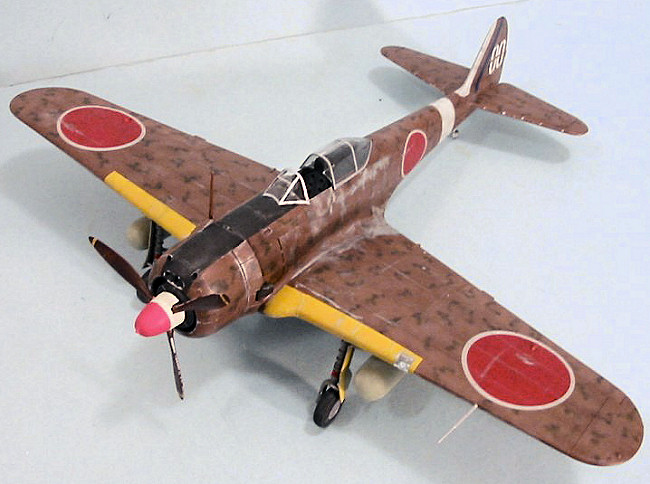
| KIT: | Hasegawa 1/32 Ki-43-II Oscar |
| KIT #: | SO 13 |
| PRICE: | $44.95 MSRP |
| DECALS: | Two options |
| REVIEWER: | Tom Cleaver |
| NOTES: | Most recent offering is Manchuoku AF boxing. |

| HISTORY |
The Nakajima Ki.43 Hayabusa (Peregrine Falcon) series first appeared in1941, as a “modern” replacement for the Ki.27, a fighter that had been built to such strict specifications that it had no growth potential. While the new Ki.43 had such modern items as retractable landing gear and a very effective “combat flap” that gave it amazing maneuverability in comparison with any other contemporary monoplanes. At the same time, it was a very conservative modernity, since it carried on the tradition of high-g close-maneuvering combat that the JAAF held to be the way to obtain air superiority. Thus, the Ki.43-I still had an armament of only two rifle-caliber machine guns, and no pilot armor or self-sealing fuel tanks.
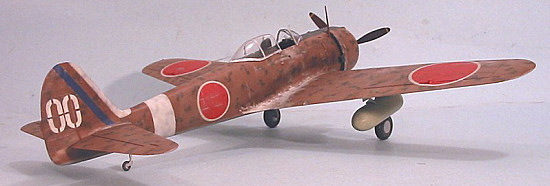 At the outbreak of the
Pacific War, only one Sentai - the 64th, led by Lt. Col. Tateo
Kato, the leading ace of the JAAF from the fighting in China - was equipped with
the Ki.43 “Hayabusa”. It was even smaller and lighter than the Zero, for which
it was frequently mistaken by such pilots as the American Volunteer Group, who
spent years arguing that their opponents over Rangoon were Zeros, not Ki.43s.
Allied pilots who tried to fight on the Hayabusa’s terms found it a deadly
opponent, while those who used their superior climb and dive capability and
avoided close-in maneuvering found the Ki.43 - which was given the Allied code
name Oscar in late 1942 - a target that easily exploded under the heavy armament
of western aircraft.
At the outbreak of the
Pacific War, only one Sentai - the 64th, led by Lt. Col. Tateo
Kato, the leading ace of the JAAF from the fighting in China - was equipped with
the Ki.43 “Hayabusa”. It was even smaller and lighter than the Zero, for which
it was frequently mistaken by such pilots as the American Volunteer Group, who
spent years arguing that their opponents over Rangoon were Zeros, not Ki.43s.
Allied pilots who tried to fight on the Hayabusa’s terms found it a deadly
opponent, while those who used their superior climb and dive capability and
avoided close-in maneuvering found the Ki.43 - which was given the Allied code
name Oscar in late 1942 - a target that easily exploded under the heavy armament
of western aircraft.
In late 1942, in response to experience in combat with western aircraft, the Ki.43-II, equipped with a more powerful engine with a three-bladed prop and an increase in armament to two .50 caliber weapons appeared, entering combat in 1943. It was obsolete from the first flight but remained in production until the end of the war.
Despite the fact it was semi-obsolescent upon its first operational assignment
in 1941, the Ki.43 series remained the backbone of fighter equipment for the
JAAF throughout the war. While the airplane was considered “meat on the table”
to many Allied pilots, in the hands of an expert pilot it was still dangerous as
late as 1944, as Lt. Col. Charles Older - the first ace of the AVG back in 1941
and by then a leader of the 23rd Fighter Group in China - discovered
on a mission to Hankow in May 1944. As he related to me in a 2002 interview,
his flight of the 23rd Fighter Group was caught at low level after
strafing one of the airfields that were their targets by several Oscars, one of
which was flown by a real expert, who managed to shoot down Older’s element
leader and both of the wingmen in the flight. Older himself only escaped by
pushing his P-51C to the maximum and employing every trick in the book to
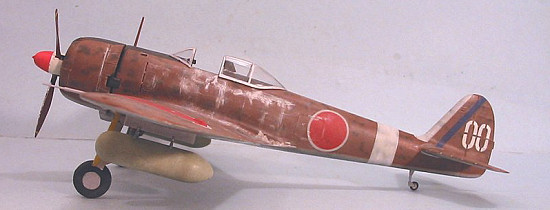 finally evade his deadly foe in
low-level combat over the city rooftops. He considered it one of the most
memorable fights he was ever in, and felt lucky to have survived.
finally evade his deadly foe in
low-level combat over the city rooftops. He considered it one of the most
memorable fights he was ever in, and felt lucky to have survived.
While no one can know for sure, there is a strong likelihood that Older had come up against Major Toshio Sakagawa, commanding officer of the 25th Sentai and one of the leading aces of the JAAF. Sakagawa is known to have shot down three P-51s with his Ki.43-II during that mission. Considered a ruthless combat pilot and leader, Sakagawa had over 40 victories at the time, having fought in China since 1938. He continued to lead the 25th Sentai in combat against the 23rd Fighter Group throughout the summer of 1944 and into the Japanese offensive that began in September. He had 45 victories by October 1944, when he was sent to the Philippines to take over command of a fighter Sentai there. He shot down at least four other American aircraft over Leyte in November 1944, flying Oscars against the elite 49th and 475th Fighter Groups. In December, with 49 victories to his credit, Sakagawa was killed while flying as a passenger in a Japanese DC-3, during evacuation back to Formosa.
As an exclamation point to the fact the obsolete Oscar could be dangerous to the most experienced American pilots, Tommy McGuire, the second-ranking American ace, was killed in combat against an Oscar flown by Japanese ace Warrant Officer Akira Sugimoto, on January 7, 1945 (though it is not clear that Sugimoto had any direct role on McGuire’s loss). Even top aces like McGuire and Older could underestimate the agile Oscar, to their extreme discomfort.
| THE KIT |
Hasegawa released their 1/32 Ki.43-II in the late 1970s. The kit has been
available in several different releases over the years, and is currently
available in a limited release with markings for the Manchurian Air Force. The
earlier kits are available from 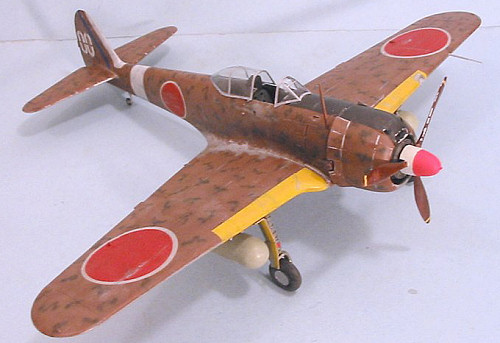 dealers
at shows, which is where I picked up this kit, which is from the first release.
dealers
at shows, which is where I picked up this kit, which is from the first release.
As with several of their other 1/32 releases, the Oscar kit provides excellent surface detail, with very petite raised rivets and some raised panel lines that - in this scale - more accurately portray real surface detail than the now de rigeur engraved panel lines that are actually less accurate representations of aircraft surfaces than the earlier raised detail.
The cockpit is Spartan, but then the actual Oscar cockpit was pretty Spartan. Given the fact that once the fuselage halves are glued together it’s hard to see much detail through the small cockpit opening, what’s there is more than adequate for an out-of-box build, though a super-detailer could also improve the look of the completed kit. There is no aftermarket resin cockpit for this kit that I am aware of.
The decals are typical Hasegawa, with an “ivory” white, and Hinomarus that are really a bit too bright, though they do tone down when applied over a dark surface since they are not completely opaque. Markings include the double-zero tail marking for Major Sakagawa of the 25th Sentai.
| CONSTRUCTION |
As with the Zero, this kit goes together without problem, and needs only a bit of Mr. Surfacer for the fuselage centerline. I rescribed panel detail and restored rivet detail that was sanded off, using a pounce wheel. The kit is so easy to assemble that, even with time spent painting the cockpit interior in JAAF “Nakajima Green”, I assembled the model in an afternoon. (Of course Tom 'forgot' to mention that he stepped on the canopy and spilled glue on one wing, which delayed construction a bit ;o). Must be a trait of advancing years, eh? Ed )
| COLORS & MARKINGS |
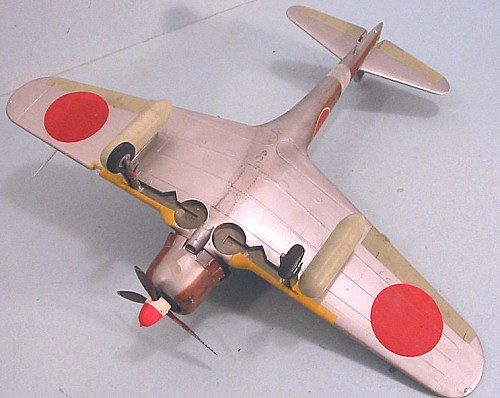 Painting:
Painting:
Armed with a profile of Sakagawa’s airplane in the Osprey “Japanese Army Air Force Aces 1937-45", I first painted the control surfaces and drop tanks with Tamiya “Japanese Army Grey,” then masked them off. I then painted the white fuselage stripe and leading edge of the vertical fin, leaving the finish a bit “rough” so it would look weathered in the end. I painted the anti-glare panel with Tamiya “NATO Black.” All this was masked off with Tamiya tape.
I then applied SNJ Aluminum to the lower surfaces. The upper surface color was done with Xtracrylix “Signalbraun, RAL8002," lightened with white to simulate sun fading. The blotches were done with Xtracrylix “Medium Green.” I gave the upper surfaces and the control surfaces a coat of Xtracrylix Gloss Varnish after unmasking.
Decals:
Surprisingly, the old kit decals went on without trouble using MicroSol.
| FINAL CONSTRUCTION |
After
I applied the tail markings, I overpainted the double-zero markings with
Xtracrylix “White” by hand, a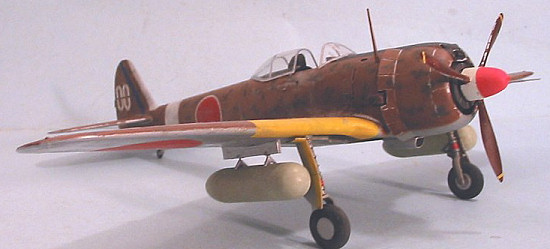 nd
did the same to the Sentai leader’s stripe, using Xtracrylix “Blue RLM24.” The
prop spinner was done with Xtracrylix “White” and “Red Arrows Red” while the
landing gear and wheel wells were painted with Xtracrylix “RLM02 Grey-green,”
with an overcoat of Tamiya “Smoke.”
nd
did the same to the Sentai leader’s stripe, using Xtracrylix “Blue RLM24.” The
prop spinner was done with Xtracrylix “White” and “Red Arrows Red” while the
landing gear and wheel wells were painted with Xtracrylix “RLM02 Grey-green,”
with an overcoat of Tamiya “Smoke.”
The profile shows the airplane heavily weathered, which I did using drybrushed Model Master Aluminum.
I then gave the model a coat of Xtracrylix Flat Varnish, followed by a thin coat of Testor’s Dullcote to give a very flat finish. I also applied exhaust stains with Tamiya “Smoke.”
I finished off by attaching the landing gear, drop tanks, prop and canopy, which I set in the open position.
| CONCLUSIONS |
This old kit is still very competitive. It is accurate in outline, and provides sufficient detail for a good out of the box model, while also providing opportunity for super-detailing of the cockpit for those with a mind to do so. The Ki.43 Hayabusa is a historically-important airplane of the Pacific War and this kit looks quite nice sitting on the shelf next to the new Hasegawa Ki.84 Hayate.
Kit courtesy of my wallet.
May 2006
If you would like your product reviewed fairly and quickly by a site that has over 300,000 visitors a month, please contact me or see other details in the Note to Contributors.